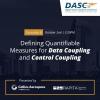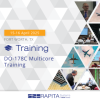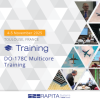The difficulty of showing that real-time software safely executes within an allotted time budget arises from the variability of code execution time. Some of this variation arises from hardware effects but a great deal arises from different paths through software.
We can reduce and even eliminate this variation at the expense of increased code size and average-case performance. Consider the following expression for saturating arithmetic:
uint32 double_uint32( uint32 x )
{
if( x > MAX / 2 )
{
x = MAX;
}
else
{
x *= 2;
}
return x;
}
This can be rewritten as:
uint32 double_uint32( uint32 x )
{
uint32 uf_mask = ((uint64)MAX / 2 - x) >> 32;
/* If x > MAX / 2 then the subtraction results in an
* unsigned underflow, with the result that
* 'uf_mask' is 0xFFFFFFFF.
* Otherwise 'uf_mask' is 0.
*/
x = ((x * 2) & ~uf_mask) | (MAX & uf_mask);
return x;
}
Similar transformations can be used to force all computation to be done using a single path, i.e. to remove all software causes of timing variation. This can lead to extremely poor performance, for example when two large functions are always called rather than just selecting one of them, but it is a powerful technique that can be used selectively to eliminate path variations that impair testability or introduce damaging timing jitter.
With regard to testing, note that such techniques make a mockery of MC/DC testing. The requirement for either version of double_uint32 is that the range boundary values (normally min-1, min, max and max+1) be explored. However MC/DC reporting will not differentiate between proper testing of the transformed version and simply calling it once with any value.

 Rapita Systems launches MACH178 Foundations for multicore DO-178C compliance
Rapita Systems launches MACH178 Foundations for multicore DO-178C compliance
 Collins Aerospace and Rapita present award winning paper at DASC 2024
Collins Aerospace and Rapita present award winning paper at DASC 2024
 Embedded Office GmbH & Co. KG and Rapita Systems announce strategic partnership
Embedded Office GmbH & Co. KG and Rapita Systems announce strategic partnership
 Control Coupling Basics in DO-178C
Control Coupling Basics in DO-178C
 Components in Data Coupling and Control Coupling
Components in Data Coupling and Control Coupling
 The ‘A’ Team comes to the rescue of code coverage analysis
The ‘A’ Team comes to the rescue of code coverage analysis
 Why there’s no standard approach for Data Coupling and Control Coupling Analysis
Why there’s no standard approach for Data Coupling and Control Coupling Analysis
 DO-278A Guidance: Introduction to RTCA DO-278 approval
DO-278A Guidance: Introduction to RTCA DO-278 approval
 ISO 26262
ISO 26262
 Data Coupling & Control Coupling
Data Coupling & Control Coupling
 Verifying additional code for DO-178C
Verifying additional code for DO-178C
 DO-178C Multicore In-person Training (Munich)
DO-178C Multicore In-person Training (Munich)
 DO-178C Multicore In-person Training (Fort Worth, TX)
DO-178C Multicore In-person Training (Fort Worth, TX)
 DO-178C Multicore In-person Training (Toulouse)
DO-178C Multicore In-person Training (Toulouse)


















